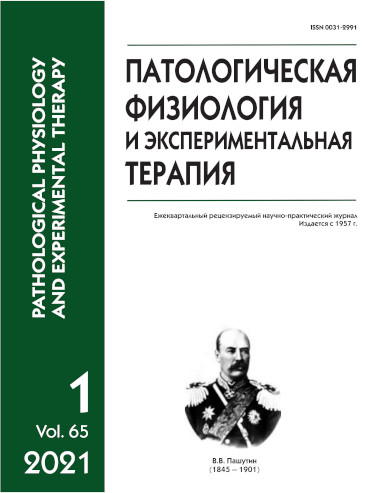Allogeneic biomaterial as an inductor of regeneration in the myocardium injured by experimental ischemia
DOI:
https://doi.org/10.25557/0031-2991.2021.01.60-69Keywords:
myocardium, ischemia, regeneration, intramyocardial administration, allogeneic biomaterial, angiogenesis, fibrosis inhibition, rats, young cardiomyocytesAbstract
Introduction. Modern technologies for recovery of injured myocardium after a heart attack are not sufficiently effective and do not meet requirements for full rehabilitation of patients. Allogeneic biomaterial is a stimulator of soft tissue regeneration and has been used in various fields of medicine, including surgery, traumatology, ophthalmology, etc. The aim of this work was to study stimulation of regeneration with a biomaterial Alloplant (BMA) in the myocardium injured by experimental ischemia. Methods. This experimental study was conducted on 100 Wistar male rats weighing 0.18-0.25 kg. All animals underwent coronary occlusion by ligation of the coronary artery. In the experimental group, a saline suspension of allogeneic biomaterial (12 mg) was injected intramyocardially into the territory of the stenosed artery simultaneously with the artery ligation. In the control group of animals, a physiological solution was administered. Histological methods used in the study included light-optical microscopy for hematoxylin and eosin staining, Mallory staining, electron microscopy, and morphometry. Hearts were taken for the study at 3, 7, 14, 30, and 45 days. Results. After the BMA intramyocardial injection into the ischemic myocardium, the scar area was 68.5% smaller than in the control group, where the biomaterial was not used. In the experimental myocardium with necrotic cardiomyocytes, an area of regeneration formed, which consisted of loose fibrous connective tissue. Extensive vascularization was observed throughout the experiment. BMA particles were phagocytized by macrophages, and products of BMA biodegradation facilitated fibrogenesis. BMA exerted a cardioprotective effect and induced cell regeneration in the ischemic myocardium. In the periinfarction zone, isolated low-differentiated cells with signs of cardiomyogenic differentiation were observed. Along with young cardiomyocytes, a large amount of Anichkov cells was found. Conclusion. Intramyocardial administration of BMA reduced the scar size in myocardial infarction. Products of BMA biodegradation slowed the scar formation, exerted a cardioprotective effect, and induced cell regeneration in the myocardium injured by ischemia.Downloads
Published
2021-03-14
Issue
Section
Original research
How to Cite
[1]
2021. Allogeneic biomaterial as an inductor of regeneration in the myocardium injured by experimental ischemia. Patologicheskaya Fiziologiya i Eksperimental’naya Terapiya (Pathological physiology and experimental therapy). 65, 1 (Mar. 2021), 60–69. DOI:https://doi.org/10.25557/0031-2991.2021.01.60-69.






